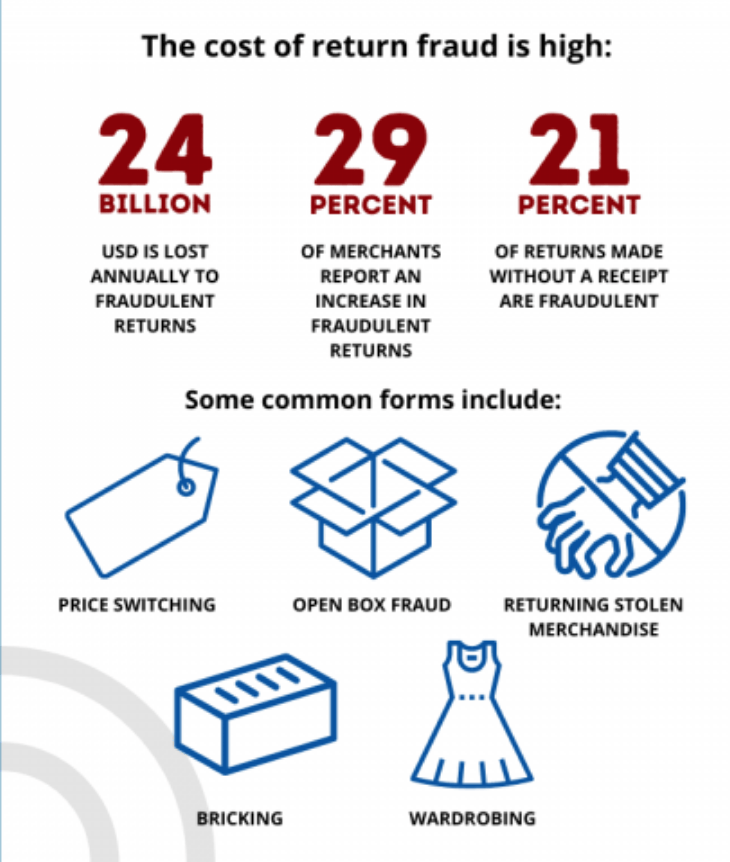
Elves on Overdrive
Increased spending = increased returns
Aside from supply chain woes, post-holiday return fraud is definitely another cause for concern, especially amidst COVID’s e-commerce boom. According to an article in Inc, this year “holiday e-commerce sales are projected to reach a record $207 billion in the U.S. between November and December, a 10 percent increase over 2020 sales”. And with holiday shopping already well underway, it’s highly probable that holiday return fraud will be a bigger issue than ever.
In our previous article on the topic, we discussed how return fraud is a multi-headed beast and can show up in a variety of ways. From fake receipts or returning a used item to returning a counterfeit posing as the real thing or buying at one store and returning at another, return fraud not only costs your business big time but it’s dangerous for other consumers.

Let’s say someone buys a fake product online and attempts to return it at a retailer where the authorized product is sold. Accepting the counterfeit as a return puts other consumers in danger because it introduces fake products into legitimate selling channels. When customers are faced with these issues over time, their trust in the brand declines, leading to a loss in consumer loyalty and retention.
This year it’s especially important to take a look at your plan for processing returns. With consumers expected to spend more this holiday season, and the holiday shopping season already well underway, you want to be prepared.

No Show
How COVID, e-commerce, and return fraud are intertwined
At Vi3, we’re all about ensuring your brand stays protected while also saving you money. That’s why we educate you on all the ways threats can sneak into your supply chain, at any stage. This year it’s especially important to think about post-holiday returns in the context of the global supply chain shortages. A few months ago, Wall Street Journal reported on a huge surge in return fraud, called “item not received” fraud, during the pandemic.
“Forter Ltd., which provides fraud-prevention technology to retailers, said some clients reported a 33% jump in “item not received” abuse over the past 12 months.”
Wall Street Journal
With a surge in online orders, and the supply chain shortages already pushing business’ resources to their limit, a lot of companies don’t have the time or resources to validate fraudulent claims. “Many retailers will simply issue a refund, particularly if the items are under $500” (WSJ). Fortune reported that “by October 2020, false claims that an item had not been received had risen by 67% compared to October 2019”. The fact that many people want contactless delivery in the time of COVID also means that reliable proof of delivery has declined.
Not to mention the billions of dollars lost annually to fraud that shows up via other means. So what can you do to stop it? Let’s take a deeper look.

Santa’s Helper
Revamp return policies and trace your products with Vi3
Combating return fraud is tricky, but with a combination of revamping your return policies, incorporating authentication technology in point of sale systems, and having traceable products, you’ll be able to save your bottom line a lot of money. You can make your products fully traceable by having unique identifiers built into them. That way, when a customer attempts a return, you can see exactly where the product came from, was purchased, or even flag if it’s a potential counterfeit.
“Most merchants keep track of returns — but the data collected is typically very basic and does not include personal information from the customer” (Merchant Fraud Journal). Implementing customer registration or profiles into your point of sale systems is one way to determine if the same customer who bought the product is the one returning it. Requiring proof of purchase and the same credit card as the purchaser can also help reduce fraud. But having a combination of consumer tracking and product tracing is the best way to help mitigate these issues.
Incorporating unique identifiers into your products allows you to see if a product was actually purchased via the same retailer the consumer is attempting to return to, as well as authenticate the product on the spot. A company who uses Vi3s tools, is able to scan the product in question in the V Enforce app. If the identifier on the product doesn’t scan, the product is definitely a counterfeit. If multiple scans arise in the system, including non-authorized distributors, then the product is also suspect. Vi3’s technology can be implemented into point of sale systems, allowing companies to pinpoint exactly where and when a product was purchased in store. This is a great solution for the shoplifted goods issue, in which sellers can immediately determine whether or not a product has ever been sold, the logistics of that sale, and whether or not these data points match up with the customer’s information.
Return fraud is going to be an issue this holiday season no matter what. The point of having a plan and implementing processes to combat return fraud is to help create the least impact possible on your business, so that you can focus on the fun stuff. Let us take part of this load off your shoulders. Contact us to chat with one of our advisors today.